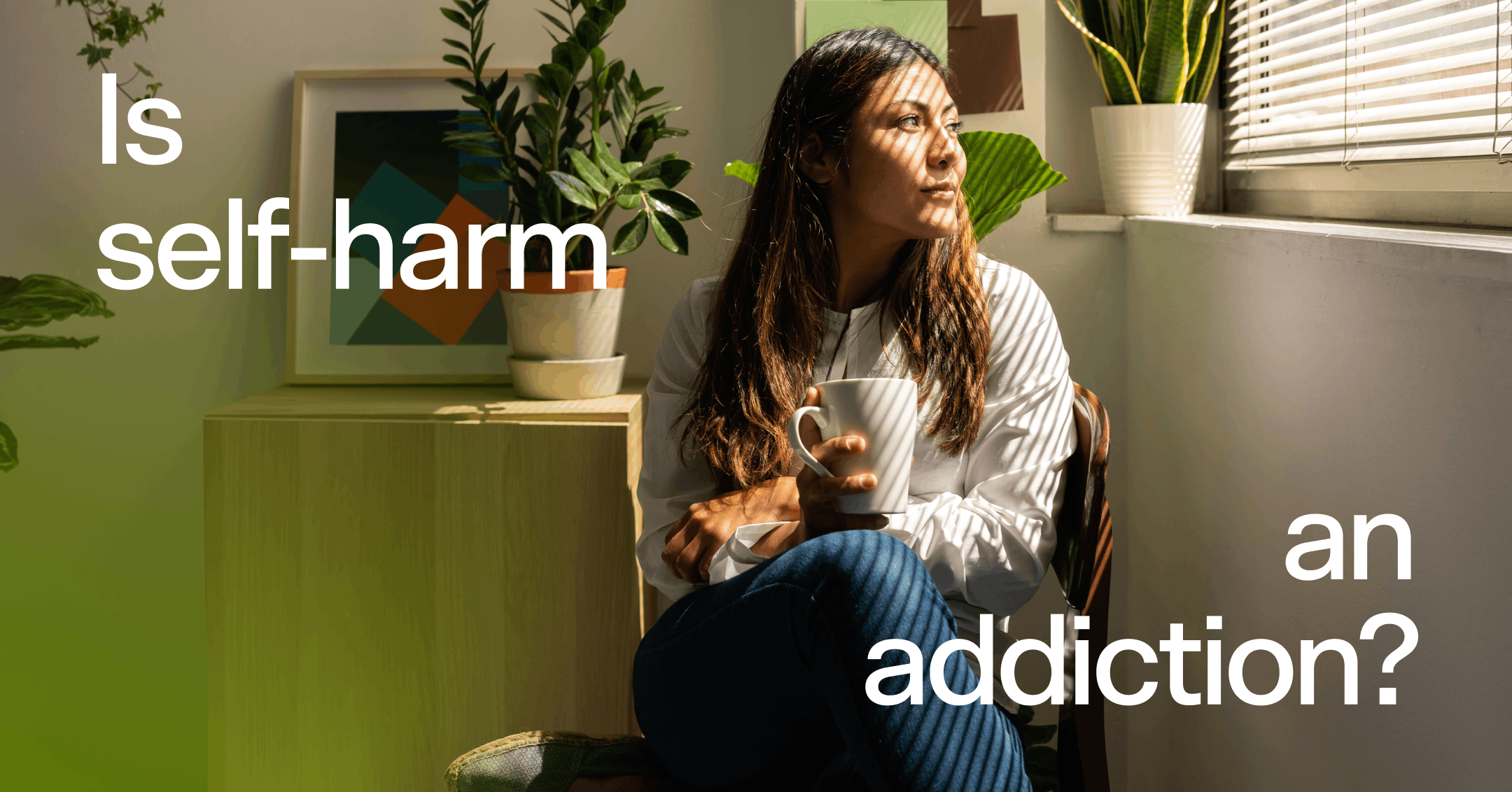Self-harm can feel like an addiction because it often involves strong behavioral urges that can feel impossible to control.
There’s an important difference between self-harm and addictions like substance use disorders (SUDs). Self-harm is typically a response to negative emotions, while substance use or misuse can occur in any emotional state.
Fortunately, there are effective supports that can help you manage the urge to self-harm. These include cognitive behavioral therapy (CBT), dialectical behavioral therapy (DBT), psychodynamic therapy, and self-care.
When you hear the term “addiction,” what do you think of? For many people, it calls to mind some form of physical or psychological dependence that negatively affects a person’s life. So when we say someone is addicted to something, it usually means they are having difficulty controlling a behavior, despite potentially harmful consequences.
With this definition in mind, it might be easy to assume that self-harm* is a form of addiction. But this isn’t necessarily the case, and researchers are still working to understand the similarities and differences between these experiences. Some view self-harm within the framework of addiction, while others point out the important differences between these experiences.
While the line between self-harm and addiction can be blurry, it shouldn’t stop you from reaching out for support. If you’re engaging in self-harm, you get to choose the language that best describes your experience. Whether you view self-harm as an addiction, compulsion, or something else, therapy can help. You can learn to manage your behavior, strengthen your mental health, and create a plan to keep yourself safe.
*The 988 Suicide and Crisis Lifeline offers 24/7 confidential support through trained crisis counselors. If you or someone you care about is experiencing emotional distress, self-harm, or a suicidal crisis, please call or text 988. For life-threatening emergencies or immediate assistance, call 911.
Why self-harming might feel addictive
Self-harm might feel addictive because it often involves irresistible urges and cravings. In addition, some people who self-injure may need to increase the intensity or frequency of the behavior to achieve the desired effect over time. They may also have trouble quitting or reducing their self-harm behaviors, even if they have a sincere desire to do so.
These effects are very similar to those described by people living with substance use disorders (SUDs), the clinical term for drug or alcohol addiction. But experts have pointed out an important difference between self-harm and SUDs: Self-harm is typically a response to negative emotions. It provides a form of temporary relief from feelings like fear, anxiety, anger, loneliness, or other challenging feelings. In contrast, substance use or misuse can occur when someone is experiencing any emotion, including positive ones like happiness or excitement.
The care you need, when you need it
Learn how Rula can support your mental health journey
How to stop self-harm addiction from taking over
Most people who self-harm require professional help to manage their behavior and stay safe. But in addition to attending therapy or accessing another form of psychiatric care, here are some strategies you can use to support your recovery:
Take 5 (or 10). If you’re feeling the urge to hurt yourself, try to delay the behavior. For example, set a timer for five minutes, and see how you feel once that time is up. You may find that the craving has subsided, and you might be able to increase this delay over time.
Distract yourself. Once you’ve made the decision to delay self-harm, consider ways to distract yourself with something positive during that time. For example, if you set a timer for five minutes, what’s something quick and enjoyable you could do? Shifting your focus to something else (for example, a funny cat video, a few minutes of gaming, a walk around the block, or texting a friend) can help you feel less tempted to self-harm.
Choose a replacement behavior. If you’ve tried delaying self-harm or distracting yourself but are still feeling the urge to hurt yourself, see if you can achieve an emotional release in a safer way. For example, you could squeeze an ice cube or take a cold shower.
Plan for relapse. Relapse is a common part of recovery from self-harm. But remember that it isn’t a sign of failure, and how you respond to a relapse matters most. If you have a temporary setback, try to practice self-compassion, leverage your coping skills, and recommit to your goals.
Addressing a self-injury addiction with treatment
If you’re engaging in self-harm, know that there are effective therapies that can help you manage your behavior, reduce the urge to hurt yourself, and address co-occurring conditions like depression or post-traumatic stress disorder.
Therapies include:
Cognitive behavioral therapy (CBT): CBT can help you recognize and interrupt unhelpful thought and behavior patterns like self-harm. It can also help you discover new coping strategies, improve your self-regulation skills, and learn to manage uncomfortable emotions in healthier ways.
Dialectical behavior therapy (DBT): DBT can be especially effective if you’re having trouble regulating your emotions. It incorporates aspects of mindfulness and self-acceptance to help you increase your distress tolerance.
Psychodynamic therapy: Psychodynamic therapy focuses on the ways past experiences can impact you in the present. This exploration can help you gain new perspectives on your thoughts, feelings, and behaviors, and these insights can help reduce the urge to self-harm.
In my experience, self-harm is usually a way to cope with emotional pain, while addiction is a compulsive behavior that isn’t always tied to emotions. Understanding this difference helps guide the right treatment.

Brandy Chalmers, LPC
Clinical reviewer
Find care with Rula
Self-harm can feel like an addiction because it often involves urges that are difficult to control. However, there’s an important difference between addictions like SUDs and self-harm, because self-harm is typically a response to negative emotions. If you’re feeling like you’re addicted to self-harm, know that you’re not alone. There are therapists who can help you navigate uncomfortable emotions, change harmful behaviors, and learn to respond to stress in healthier ways.
At Rula, we’re committed to delivering a comprehensive behavioral health experience that helps people feel seen and understood so they can get back to feeling their best.
Rula makes it easier to find a licensed therapist or psychiatric provider who accepts your insurance so you don’t have to choose between affordable care and excellent care. With a diverse network of more than 15,000 providers, 24/7 crisis support, and appointments available as soon as tomorrow, we’re here to help you make progress — wherever you are on your mental health journey.
Rula's editorial process
Rula's editorial team is on a mission to make science-backed mental health insights accessible and practical for every person seeking to better understand or improve mental wellness.
Members of Rula’s clinical leadership team and other expert providers contribute to all published content, offering guidance on themes and insights based on their firsthand experience in the field. Every piece of content is thoroughly reviewed by a clinician before publishing.




